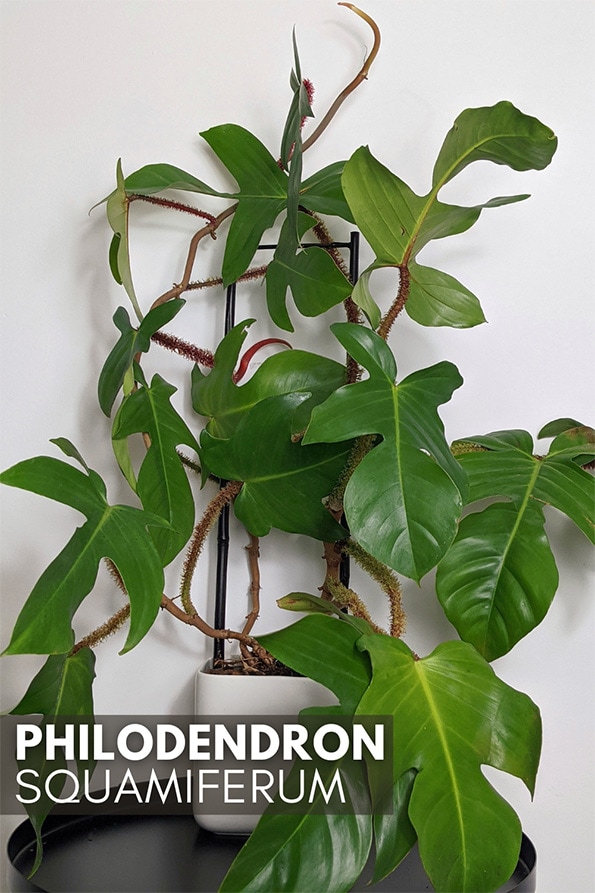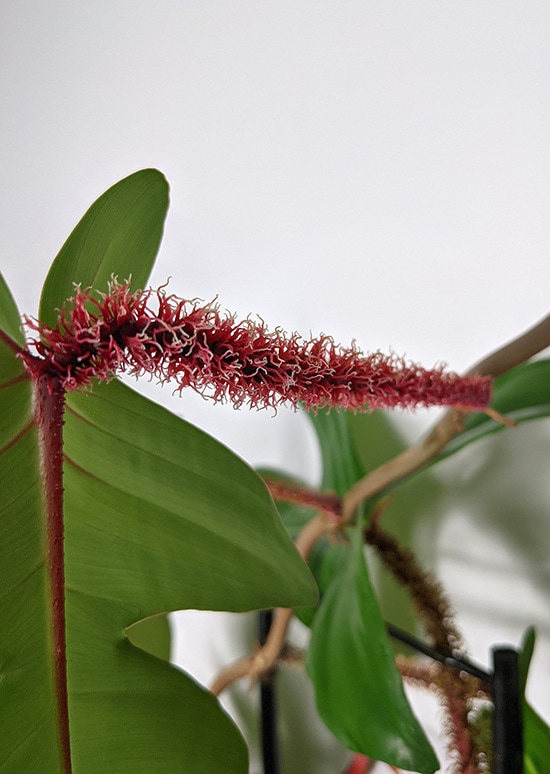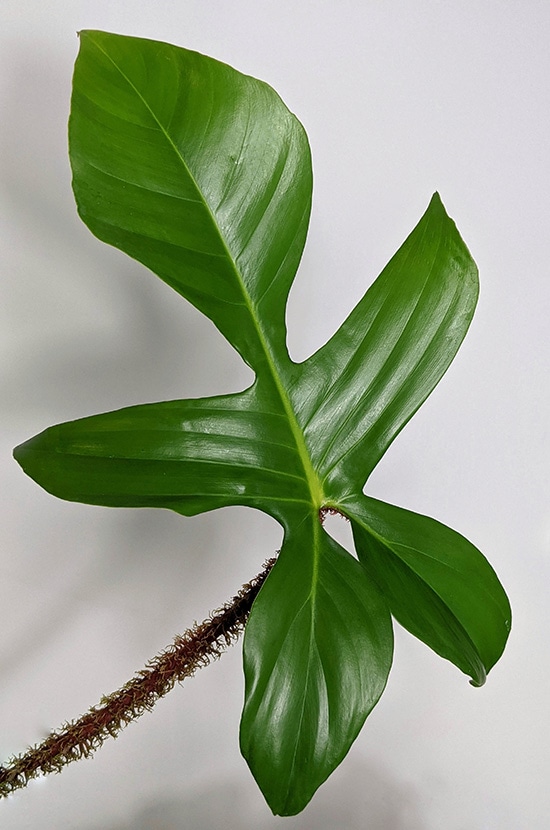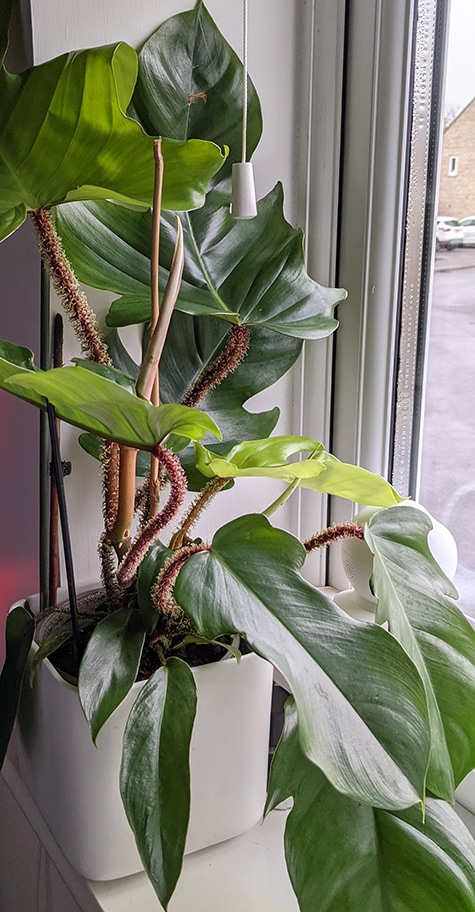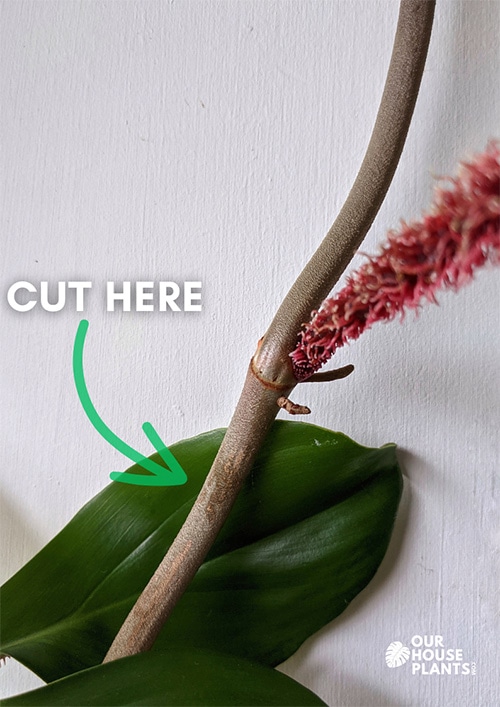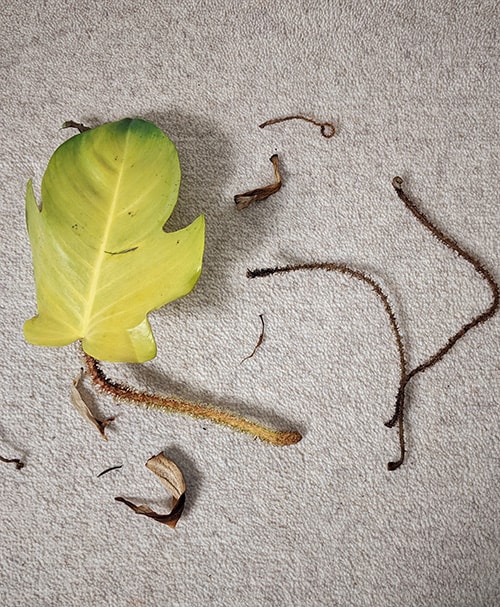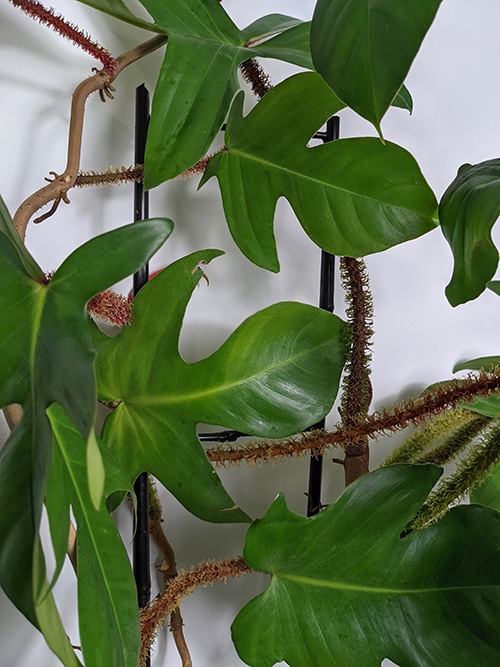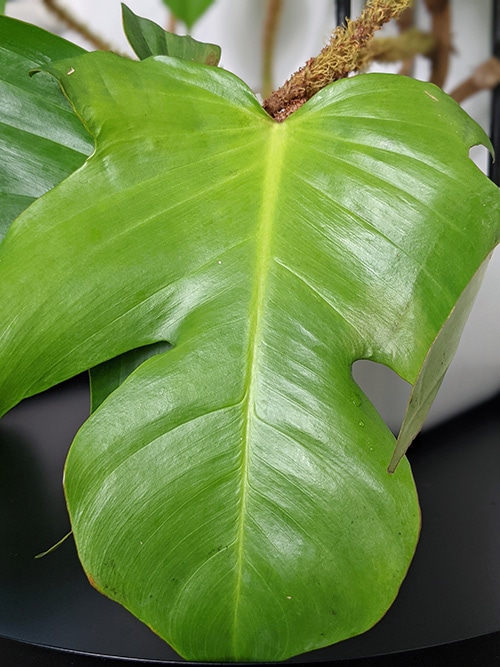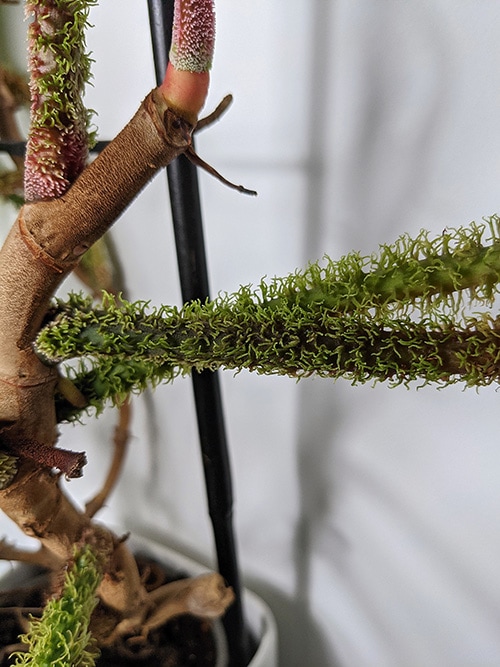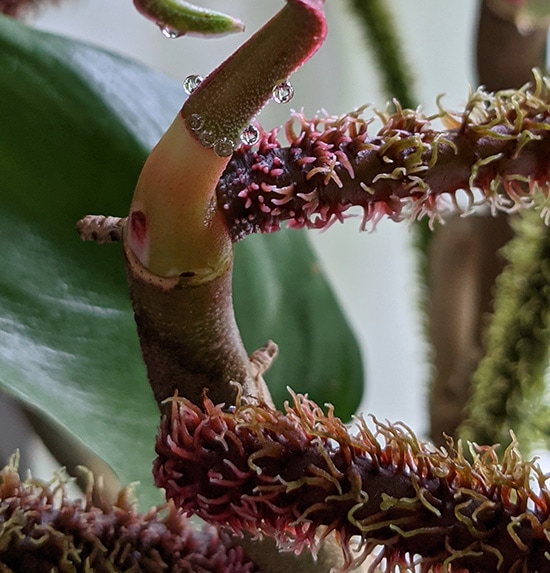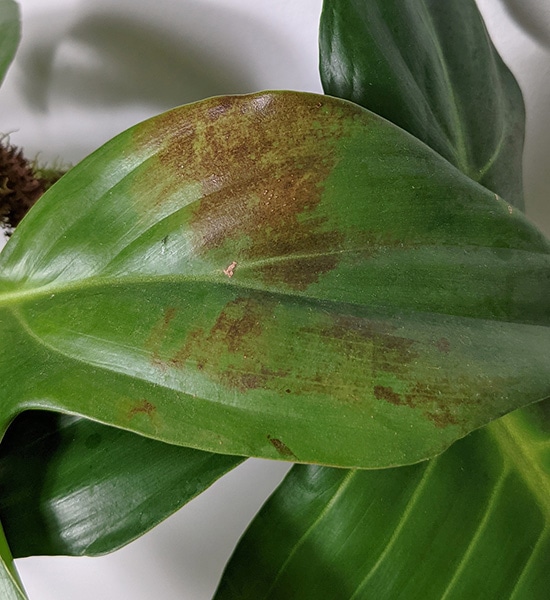Also known as the Red Bristle Philodendron due to its vibrant red fuzzy leaf petioles, Philodendron Squamiferum is a somewhat rare and less common houseplant.
While not as low maintenance as some indoor plants, it's one of the more forgiving Philodendron varieties. So if you like its unusual characteristics, it's worth a go.
This article provides background information on the plant, a detailed care guide from my experiences of growing it, and troubleshooting tips to help you care for and grow your Philodendron Squamiferum well.
These can be elusive plants to find in stores, but their red stems and shaped foliage make them unique and worth searching for.
Native to tropical parts of northern Brazil, they can cope well in most homes and tolerate various lighting arrangements.
It's not too fussy with watering either, and if you forget to water them they don't mind be allowed to dry out for a few days.
How do you pronounce Philodendron Squamiferum correctly? Say:
Phil-oh-DEN-dron Skwah-MIF-er-um
The stems are one of the main standout features of this plant and why it's called Red Bristle Philodendron or the Hairy Philodendron.
It's this feature that helps give it a striking and unusual appearance compared to other Philodendron species.
This Philodendron is known for its unique reddish stems adorned with tiny bristles, creating a fuzzy texture to its appearance.
The leaves, like many other Philodendrons change as the plant matures. Initially young plants will have less pronounced leaf shapes, but as they age they become more intricate and lobbed.
The plant will eventually start producing leaves with five distinct lobes that (to me at least, resemble a gingerbread man shape. After this point, the leaves will just keep getting bigger bigger.
The Mature form of a Philodendron Squamiferum leaf (it also reminds me of the Gingerbread Man Gingy from Shrek. Can you see it too?)
It's a pity they're not more popular houseplants, but that may change in time. Up next is my full care guide for the Philodendron Squamiferum.

Hi, I'm Tom!
If you're like me and enjoy the challenge of growing houseplants and getting them to thrive, then Ourhouseplants can help. This website shares my knowledge and years of growing plants and provides (hopefully) helpful advice on properly caring for your indoor plant friends.
The Squamiferum does best in bright locations away from harsh sunlight. Avoid placing it in full sun, as this can scorch its leaves and cause damage.
Close to an East or West facing window might be acceptable (that's where I grow mine), but keep an eye on your plant and move it if you notice damage.
It can tolerate lower light conditions, but it will likely have slow or non-existant growth. The foliage and red petioles may also be less vibrant.
The leaves will grow and turn towards light sources so you can easily end up with a "face" or good side. If you want more even growth, you'll need to rotate the plant regularly to ensure even exposure to light.
My plant a few years back growing in a West Facing window. The leaves are turning towards the window so I rotate the container every few weeks. If space is limited, you could grow them elsewhere and supplement with artificial grow lights.
Philodendron Squamiferum prefers moderately moist soil, but allow the top few inches of the soil to dry out between waterings to prevent overwatering and root rot.
Water thoroughly when the soil feels dry, ensuring proper drainage to prevent water-logging. Avoid letting the plant sit in standing water, as this can lead to rot.
You'll need to adjust watering frequency based on environmental conditions such as temperature, humidity, and light levels. If the soil is still wet a week after watering, you need to give less water, or move the plant to a warmer location or one with more light.
During the winter months or in cooler conditions, reduce watering frequency to prevent waterlogged soil.
This is a tolerant Philodendron. Yes, it prefers higher humidity, but it will still grow well in most home environments. If the humidity levels are 50% and above, it's going to be okay.
TIP
If you're not sure what the humidity levels are around your plants. Check out my shop for a cheap Hydrometer that I use and recommend.
Use a balanced liquid fertilizer every month or so during the Spring and Summer. Cut back or stop entirely in the Fall and Winter.
With houseplants it's better to use slightly less fertilizer than recommended to avoid over-fertilization. If you notice a build up of salts on the surface, then flush the potting mix every couple of months by running it under the tap (you should only do this if the container has a drainage hole!).
Philodendron Squamiferum thrives in warm temperatures between 18°C (65°F) and 27°C (80°F) conditions similar to its native rainforest habitat. Avoid long term exposure to temperatures below 50°F (10°C), as the cold can weaken and damage the plant.
You can watch me tell you about this plant over on YouTube
Mature plants don't need frequent repotting. Doing it every two or three years is probably enough.
Young plants in very small planters may need to be repotted every year until they reach a reasonable size. You can do it at any time of the year (even Winter), but doing it late Spring or Summer will coincide with their growing season and could help boost growth.
As with almost all Philodendrons, they're ideally looking for a reasonably light open mix, but can deal with a wide range of potting mixes.
Aroids mixes, or coconut coir would be my first recommended as this combines decent drainage with a good water holding ability. Peat-free mixes will work, but make sure they're well composted and not full of twigs or poor-quality ingredients.
If you want to propagate your Philodendron squamiferum, then stem cuttings are the best way to do it.
Choose a healthy stem with at least one leaf and one node (where leaves and aerial roots emerge). Cut just below the node using clean, sharp scissors or pruning shears.
You can take cuttings from a healthy plant like this. Cut the stem a little below a node, you may see older aerial roots coming from the node, this is fine and you can leave them in place.
Then, you drop the cutting into a vase of water. The leaf and its stem need to be above the water, so if that's not easy to do with your chosen cutting/vase shape, you can cut lower down the stem to give you more lenght.
Put the vase and cutting in a warm bright location and new roots should start to grow from the node after a few weeks. Let the roots get a little longer and after a month or two you can move it into a soil based potting mix.
Generally, it's considered a moderately fast-growing plant when provided with optimal growing conditions. A brand new leaf or two each month during Spring and Summer is normal.
The speed of growth of Philodendron Squamiferum can vary depending on various factors such as light, temperature, humidity, and care practices. Expect little or no growth in low light locations and over the cooler months of the year.
Can you Prune to Create a Bushy Plant?
You can prune off stems if they're becoming unruly and this often triggers a side shoot to form from the node near where you made the cut. However some Philodendrons including the Squamiferum, do not typically produce multiple side shoots, so pruning is unlikely to create a bushy look.
This is a vining plant so it can get pretty tall if given support to let it climb upwards. However most people run out of space and tend to keep it more compact at around 2 to 3 feet (60 to 90 centimeters).
Pruning can help with the overall height if they're getting too big. The stems have some flex too, so you can tie them into shape on a trellis or moss pole.
Mature Philodendrons sometimes flower indoors, but the blooms are unremarkable and not usually why people choose to grow these plants.
The Squamiferum contains calcium oxalate crystals, which can cause irritation, an upset stomach and swelling of the mouth, tongue, and throat if chewed or eaten by pets. It's unlikely to cause long term issues, but if you have a pet that eats your houseplants it might be best to keep them apart.
Each leaf emerges from a sheath that eventually splits and goes brown and papery. The hairy red leaf stalks will also drop bits over time. All of these things need picking off or removing.
The Squamiferum has large numbers of extrafloral nectaries and glandular trichomes that secrete a slightly sticky, sweet fluid that can leave marks on leaves. The leaves also get dusty, so you will need to wipe everything down from time to time.
Although they're easy plants I've never found Philodendron Squamiferum to be truly low maintenance. They always need a bit of fussing every now and again, but it's easily dealt with.
This is a climbing plant and it wants to go upwards. They don't grow well or look good if allowed to sprawl or trail downwards. Some support is almost always necessary for a good looking plant aesthetic.
Some Aroids like the Monstera do very well on moss poles. This provides support and encourages the leaves to fenestrate. You can grow the Squamiferum on one too, but you don't need to as it's quite happy with only basic support.
I use a wooden trellis to help keep things orderly and in shape. The stems have some flex to them so you can easily move things around to your liking.
I really like the contrast of the black trellis against the dark green leaves and red coarse hairs. But you can go for any color support that suits your decor and style.
The squamiferum is more uncommon than rare. However it's unusual enough that most people won't have seen one before, so it could be a great talking point or attract attention from visitors.
The Squamiferum plant did gain popularity in the recent houseplant boom, but it's not universally liked. Three factors tend to deter people or limit more widespread appeal.
Firstly, while not pricey, availability is limited and they're challenging to find in standard houseplant stores, often requiring purchase from a specialist seller.
Secondly, they're unruly climbers with a twisting growth habit and pruning offers limited success. So aesthetically, although the leaf shape and the red hairy bristles are attractive, the growth habit might not be for everyone.
Lastly, they can be messy. The hairy bristles easily shed and stems produce sticky residue (more on this later). Each new leaf is shielded by cataphylls that eventually turn brown and papery and these split and need removing.
All of this is a shame though as most owners will (hopefully) tell you they're good plants to grow.
Yellow Leaves.
Yellow leaves can be normal or a sign of a problem. Occasional leaves lower down the plant will go yellow with age and this is to be expected.
Lots of leaves going yellow or leaves higher up the plant are typically a sign of overwatering.
Leaves Slightly Yellow.
Sometimes, a leaf starts to go yellow, and then it doesn't progress further. You can see this happening in the photo below.
One of the first signs of underfeeding is leaf discoloration on the tropical-looking foliage and lack of growth generally.
If this is happening then it's usually down to one of the following. Mild overwatering, pests (Thrips) too much light or underfeeding. Not enough feed is the most likely reason, if you start to feed from this point on the yellowing may reverse.
Leaf Petioles Going Green.
The brilliant red leaf petioles will go green over time. This is a natural aging quirk of the plant and you can't prevent it. Enjoy the green fuzzy-ness instead.
The hairy stems on the rare philodendron squamiferum normally have a red hue. However with age they lose this coloring and go green.
Sticky Drops.
On a healthy Philodendron Squamiferum this is very common due to the presence of extrafloral nectaries. There are generally two views why this happens. I'm minded to think it's a bit of both.
The first is that the sticky substance is attractive to beneficial insects like ants. When outdoors the plant attracts ants to "farm" the plant and get rid of damaging pests and insects. In return the ants get a food source.
The second view is that the sticky drops help to trap damaging pests and repel them.
The sap can be annoying, but they do ward off pest infestations and can help protect the impressive foliage from insect damage.
However indoors, this sticky substance has limited use and may even be annoying as it can ruin the look of the leaves and end up on nearby walls or surfaces. You can wipe down the leaf with a damp cloth and it usually comes off without much hassle.
Brown Leaves / Damage.
Browning can be fairly common on the Squamiferum. The top reasons are below.
Crispy leaf tips or browning on the leaf surface can have several causes. People often assume fungal infections are to blame, but fortunately these are fairly rare on houseplants.
Philodendron squamiferum not growing.
You won't get much growth on your squamiferum in low light areas, if it's in a cool room, and over winter. Rootbound plants tend not to grow either and so a repot or to more frequent feeding may be in order.
